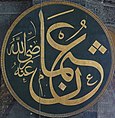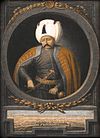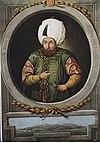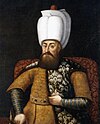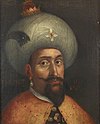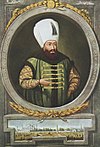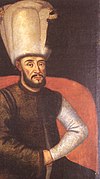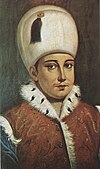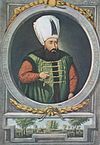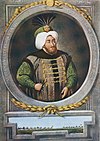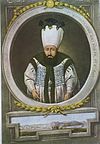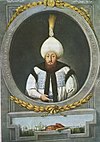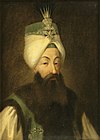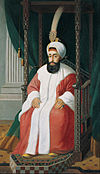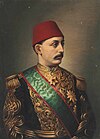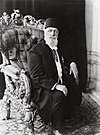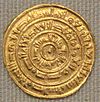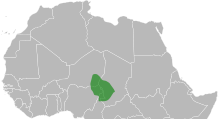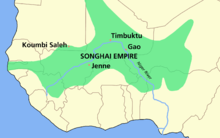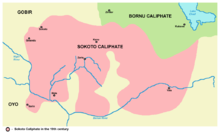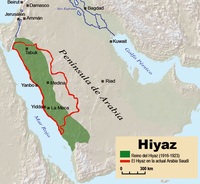
The Umayyad Caliphate or Umayyad Empire was the second caliphate established after the death of the Islamic prophet Muhammad and was ruled by the Umayyad dynasty. Uthman ibn Affan, the third of the Rashidun caliphs, was also a member of the clan. The family established dynastic, hereditary rule with Mu'awiya I, the long-time governor of Greater Syria, who became caliph after the end of the First Fitna in 661. After Mu'awiya's death in 680, conflicts over the succession resulted in the Second Fitna, and power eventually fell to Marwan I, from another branch of the clan. Syria remained the Umayyads' main power base thereafter, with Damascus as their capital.

Mu'awiya I was the founder and first caliph of the Umayyad Caliphate, ruling from 661 until his death. He became caliph less than thirty years after the death of the Islamic prophet Muhammad and immediately after the four Rashidun ('rightly-guided') caliphs. Unlike his predecessors, who had been close, early companions of Muhammad, Mu'awiya was a relatively late follower of Muhammad.

Abu al-Abbas Abd Allah ibn Muhammad ibn Ali ibn Abd Allah, known by his laqab al-Saffah, was the first caliph of the Abbasid Caliphate, one of the longest and most important caliphates in Islamic history.
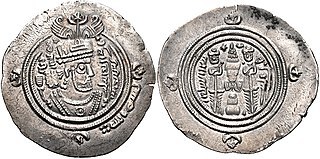
Yazid ibn Mu'awiya ibn Abi Sufyan, commonly known as Yazid I, was the second caliph of the Umayyad Caliphate. He ruled from April 680 until his death in November 683. His appointment by his father Mu'awiya I was the first hereditary succession to the caliphate in Islamic history. His caliphate was marked by the death of Muhammad's grandson Husayn ibn Ali and the start of the crisis known as the Second Fitna.
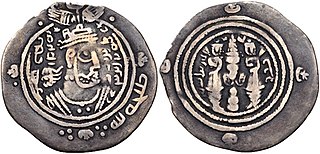
Marwan ibn al-Hakam ibn Abi al-As ibn Umayya, commonly known as Marwan I, was the fourth Umayyad caliph, ruling for less than a year in 684–685. He founded the Marwanid ruling house of the Umayyad dynasty, which replaced the Sufyanid house after its collapse in the Second Fitna and remained in power until 750.

Bilad al-Sham, often referred to as Islamic Syria or simply Syria in English-language sources, was a province of the Rashidun, Umayyad, Abbasid, and Fatimid caliphates. It roughly corresponded with the Byzantine Diocese of the East, conquered by the Muslims in 634–647. Under the Umayyads (661–750) Bilad al-Sham was the metropolitan province of the Caliphate and different localities throughout the province served as the seats of the Umayyad caliphs and princes.

A caliphate or khilāfah is a monarchical form of government originated in the 7th century Arabia, whose political identity is based on claim of succeed to the Islamic State of Muhammad and the identification of a monarch called caliph as his heir and successor. The title of caliph, which was the equivalent of titles such as king, tsar, and khan in other parts of the world, had led to many civil wars, sectarian conflicts, and parallel regional caliphates. Historically, the caliphates were polities based on Islam which developed into multi-ethnic trans-national empires. During the medieval period, three major caliphates succeeded each other: the Rashidun Caliphate (632–661), the Umayyad Caliphate (661–750), and the Abbasid Caliphate (750–1517). In the fourth major caliphate, the Ottoman Caliphate, the rulers of the Ottoman Empire claimed caliphal authority from 1517 until the Ottoman caliphate was formally abolished as part of the 1924 secularisation of Turkey. An attempt to preserve the title was tried, with the Sharifian Caliphate, but this caliphate fell quickly, leaving the claim in dormancy.

The Alids are those who claim descent from Ali ibn Abi Talib, the fourth Rashidun caliph and the first imam in Shia Islam. Ali was also the cousin and son-in-law of the Islamic prophet Muhammad. The main branches are the Hasanids and Husaynids, named after Hasan and Husayn, the eldest sons of Ali from his marriage to Fatima, the daughter of Muhammad. As the progeny of Muhammad, they are revered by all Muslims. The Alids have led various movements in Islam, and a line of twelve Alids are the imams in Twelver Shia, the largest Shia branch.

Abd Allah ibn al-Zubayr ibn al-Awwam was the leader of a caliphate based in Mecca that rivaled the Umayyads from 683 until his death.
The ten to whom Paradise was promised were ten early Muslims to whom, according to Sunni Islamic tradition, the Islamic prophet Muhammad had promised Paradise.
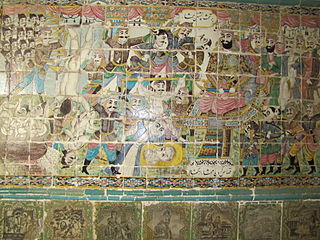
Al-Mukhtar ibn Abi Ubayd al-Thaqafi was a pro-Alid revolutionary based in Kufa, who led a rebellion against the Umayyad Caliphate in 685 and ruled over most of Iraq for eighteen months during the Second Fitna.
The Banu Kalb was an Arab tribe which mainly dwelt in the desert and steppe of northwestern Arabia and central Syria. It was involved in the tribal politics of the Byzantine Empire's eastern frontiers, possibly as early as the 4th century. By the 6th century, the Kalb had largely adopted Christianity and came under the authority of the Ghassanids, leaders of the Byzantines' Arab allies. During the lifetime of the Islamic prophet Muhammad, a few of his close companions were Kalbites, most prominently Zayd ibn Haritha and Dihya, but the bulk of the tribe remained Christian at the time of Muhammad's death in 632. They began converting in large numbers when the Muslims made significant progress in the conquest of Byzantine Syria, in which the Kalb stayed neutral. As a massive nomadic tribe with considerable military experience, the Kalb was sought as a key ally by the Muslim state. The leading clans of the Kalb forged marital ties with the Umayyad family, and the tribe became the military foundation of the Syria-based Umayyad Caliphate (661–750) from the reign of Mu'awiya I to the early reign of Abd al-Malik.
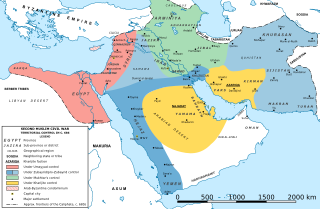
The Second Fitna was a period of general political and military disorder and civil war in the Islamic community during the early Umayyad Caliphate. It followed the death of the first Umayyad caliph Mu'awiya I in 680, and lasted for about twelve years. The war involved the suppression of two challenges to the Umayyad dynasty, the first by Husayn ibn Ali, as well as his supporters including Sulayman ibn Surad and Mukhtar al-Thaqafi who rallied for his revenge in Iraq, and the second by Abd Allah ibn al-Zubayr.

Shia Islam in Iraq has a history going back to the times of Ali ibn Abi Talib, the first imam of Shia Islam and fourth caliph of Sunni Islam who moved the capital of the early caliphate from Medina to Kufa two decades after the death of Muhammad. Today, Shia Muslims make up around 55% of the Iraqi population. Iraq is the location of the holy cities of Najaf and Karbala, pilgrimage sites for millions of Shia Muslims.
The Umayyad dynasty or Umayyads was an Arab clan within the Quraysh tribe who were the ruling family of the Caliphate between 661 and 750 and later of al-Andalus between 756 and 1031. In the pre-Islamic period, they were a prominent clan of the Meccan tribe of Quraysh, descended from Umayya ibn Abd Shams. Despite staunch opposition to the Islamic prophet Muhammad, the Umayyads embraced Islam before the latter's death in 632. Uthman, an early companion of Muhammad from the Umayyad clan, was the third Rashidun caliph, ruling in 644–656, while other members held various governorships. One of these governors, Mu'awiya I of Syria, opposed Caliph Ali in the First Muslim Civil War (656–661) and afterward founded the Umayyad Caliphate with its capital in Damascus. This marked the beginning of the Umayyad dynasty, the first hereditary dynasty in the history of Islam, and the only one to rule over the entire Islamic world of its time.
Abū Muḥammad ʿAbd Allāh ibn ʿAlī was a member of the Abbasid dynasty, and played a leading role in its rise to power during the Abbasid Revolution. As governor of Syria, he consolidated Abbasid control over the province, eliminating the remnants of the Umayyad dynasty and suppressing pro-Umayyad uprisings. After the death of his nephew and first Abbasid caliph, al-Saffah, in 754, he launched a bid for the caliphal title against al-Saffah's brother, al-Mansur, but was defeated and imprisoned. He was killed in 764.
Ziyād ibn ʿAbd Allāh ibn Yazīd ibn Muʿāwiya, commonly known as Abū Muḥammad al-Sufyānī was an Umayyad prince and a pretender to the Umayyad Caliphate, which had been overthrown by the Abbasid Caliphate in early 750. Abu Muhammad led a revolt against the Abbasids, but his forces were defeated and he fled to the Hejaz, where he was killed in the early part of the Abbasid caliph al-Mansur's reign.
Abū al-Ḥasan ʿAlī ibn ʿAbd Allāh ibn Khālid ibn Yazīd ibn Muʿāwiya ibn Abī Sufyān, better known as Abū al-ʿUmayṭir al-Sufyānī, was an Umayyad rebel against Abbasid rule in Syria during the Fourth Muslim Civil War and a self-proclaimed messiah who, in 811, attempted to restore the Umayyad Caliphate, which had been toppled by the Abbasids in 750. He expelled the Abbasid governor of Syria, Sulayman ibn Abi Ja'far, from Damascus and set up a quasi-administration in the city. His claim to the caliphate soon after gained recognition in different parts of the Damascus, Homs and Qinnasrin districts, including the port of Sidon and city of Homs.
Abān ibn Muʿāwiya ibn Hishām ibn ʿAbd al-Malik was an Umayyad prince and commander who led a failed revolt against the Abbasid Caliphate shortly after the toppling of the Umayyad Caliphate in 750.


